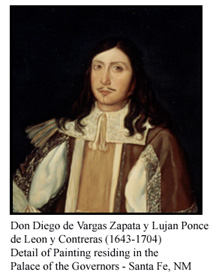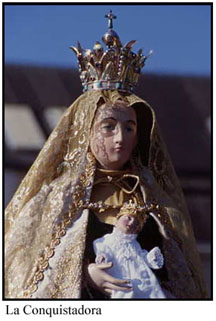

History of Fiesta
The cry of "Viva la Fiesta" has been reverberating through the streets of
Old Santa Fe every autumn for 299 years. The sound generates a curious blend of
thanksgiving, revelry and pride in the hearts of Santa Feans who celebrate Fiesta
annually to commemorate Don Diego De Vargas' peaceful reoccupation of the City of
Holy Faith in 1692.
The historic capital is one of the oldest in the United States. It was established by
Don Juan de Oņate at San Gabriel in 1598 and moved over 30 miles south to the foot of
the Sangre de Cristo Mountains where Santa Fe was founded in 1610.
In 1680 the Indians
revolted, burned the city and drove out the Spanish colonists, who fled to Guadalupe del
Paso, now Juarez, Mexico. They rescued from the burning church the 29-inch wood carved
Marian statue, La Conquistadora, originally brought to Santa Fe in 1625 by the missionary,
Fray Alonso de Benavides.
 Twelve years later, the King of Spain appointed Don Diego De Vargas to join the exiles in
Guadalupe del Paso and organize a campaign for the resettlement of Santa Fe. He accomplished
this difficult and remarkable mission without bloodshed on September 4, 1692. In December
of the next year, the Indians resisted when De Vargas returned from a trip to recruit more
colonists, so he set up an encampment outside the city near the present site of the Rosario
Chapel. The anxious colonist placed La Conquistadora on a makeshift altar and implored her
to intercede for the successful re-entry into the town. Before the end of December 1693, De
Vargas led his triumphant forces back into the City of the Holy Faith where La Conquistadora
was likely enshrined temporarily in the Palace chapel. Crediting the Madonna's intercession
with his victory, De Vargas is said to have vowed restoration of her throne in the parish church
built by Fray Benavides in 1692 and destroyed by the Indians in 1680. The General De Vargas
died on April 4, 1704 without achieving this goal.
Twelve years later, the King of Spain appointed Don Diego De Vargas to join the exiles in
Guadalupe del Paso and organize a campaign for the resettlement of Santa Fe. He accomplished
this difficult and remarkable mission without bloodshed on September 4, 1692. In December
of the next year, the Indians resisted when De Vargas returned from a trip to recruit more
colonists, so he set up an encampment outside the city near the present site of the Rosario
Chapel. The anxious colonist placed La Conquistadora on a makeshift altar and implored her
to intercede for the successful re-entry into the town. Before the end of December 1693, De
Vargas led his triumphant forces back into the City of the Holy Faith where La Conquistadora
was likely enshrined temporarily in the Palace chapel. Crediting the Madonna's intercession
with his victory, De Vargas is said to have vowed restoration of her throne in the parish church
built by Fray Benavides in 1692 and destroyed by the Indians in 1680. The General De Vargas
died on April 4, 1704 without achieving this goal.
 Eight years after the death of De Vargas, Lt. Governor Paez Hurtado who had been one of this
Captains and a close friend, influenced city officials to draft a proclamation for an annual
celebration commemorating the peaceful 1692 resettlement. The 1712 proclamation establishing
the first Fiesta de Santa Fe, was signed by Governor Marquez de La Peņuela. The document specified
a mass, vespers, and a sermon, thus setting the religious tone still characterizing modern fiestas.
La Conquistadora is among the most venerated Marian figures in the world. She was crowned in 1954
by Cardinal Francis Spellman and again in 1960 by an apostolic representative of Pope John XXIII.
Her golden crown is studded with precious stones, including a three-carat diamond. Her extensive
wardrobe includes an exquisite lace mantilla from Sevilla Spain and an elaborate costume fashioned
from ancient French vestments found in the old Cathedral museum. They appear to be of the secular
and American periods of Bishop Lamy's clergy.
And so it is that La Conquistadora, a conqueror of hearts, and De Vargas, a conquistador of the
new world, join forces to inspire our unique and enduring celebration, la Fiesta de Santa Fe,
a time of prayer, rejoicing and hospitality for all.
Eight years after the death of De Vargas, Lt. Governor Paez Hurtado who had been one of this
Captains and a close friend, influenced city officials to draft a proclamation for an annual
celebration commemorating the peaceful 1692 resettlement. The 1712 proclamation establishing
the first Fiesta de Santa Fe, was signed by Governor Marquez de La Peņuela. The document specified
a mass, vespers, and a sermon, thus setting the religious tone still characterizing modern fiestas.
La Conquistadora is among the most venerated Marian figures in the world. She was crowned in 1954
by Cardinal Francis Spellman and again in 1960 by an apostolic representative of Pope John XXIII.
Her golden crown is studded with precious stones, including a three-carat diamond. Her extensive
wardrobe includes an exquisite lace mantilla from Sevilla Spain and an elaborate costume fashioned
from ancient French vestments found in the old Cathedral museum. They appear to be of the secular
and American periods of Bishop Lamy's clergy.
And so it is that La Conquistadora, a conqueror of hearts, and De Vargas, a conquistador of the
new world, join forces to inspire our unique and enduring celebration, la Fiesta de Santa Fe,
a time of prayer, rejoicing and hospitality for all.
Content and Images Copyright Š 2009 [Santa Fe Fiesta Inc.]. All
rights reserved.
Last Updated 8/11/11